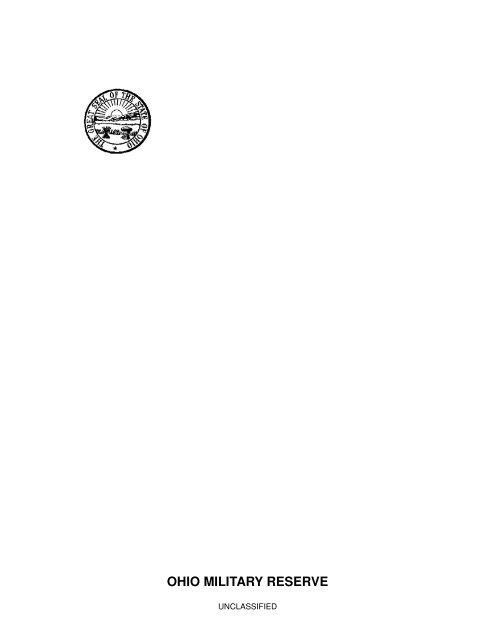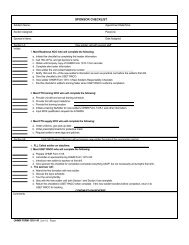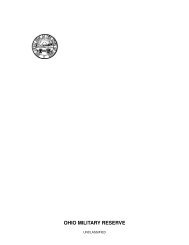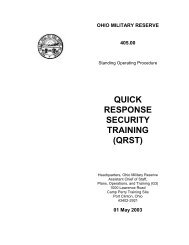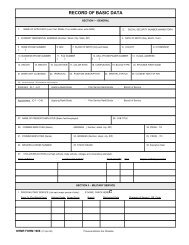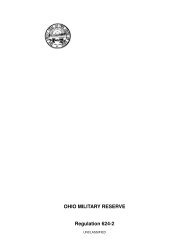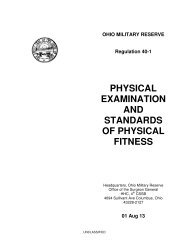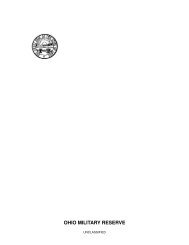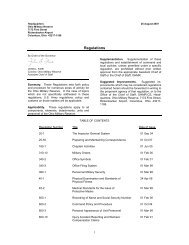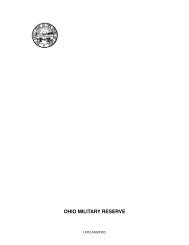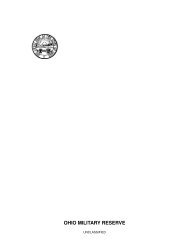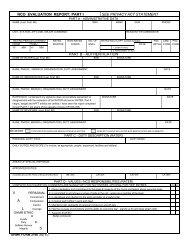OHMR Regulation 600-2 - Ohio Military Reserve
OHMR Regulation 600-2 - Ohio Military Reserve
OHMR Regulation 600-2 - Ohio Military Reserve
- No tags were found...
You also want an ePaper? Increase the reach of your titles
YUMPU automatically turns print PDFs into web optimized ePapers that Google loves.
OHIO MILITARY RESERVEUNCLASSIFIED
<strong>Regulation</strong> <strong>600</strong>-2COMMANDPOLICY ANDPROCEDUREHeadquarters, <strong>Ohio</strong> <strong>Military</strong> <strong>Reserve</strong>Office of the Assistant Chief of Staff,Personnel and Administration, G14 th Brigade (CSSB)4094 Sullivant Ave Columbus, <strong>Ohio</strong>43228-212701 July 2011Summary of ChangesThe changes noted herein are only those changes of significance or which effect ongoing operations.Changes in terminology, organization or other routine matters are not reflected.<strong>OHMR</strong> <strong>Regulation</strong> <strong>600</strong>-2, Command Policy and Procedure, dated 01 Jul 11ParagraphChangeAllRevision of Complete <strong>Regulation</strong>.2
Headquarters<strong>Ohio</strong> <strong>Military</strong> <strong>Reserve</strong>4 th Brigade (CSSB)4094 Sullivant AveColumbus, <strong>Ohio</strong> 43228-212701 July 2011<strong>OHMR</strong> <strong>Regulation</strong> <strong>600</strong>-2Command Policy and ProcedureBy Order of the Governor:JOHN L. FAIRColonel, <strong>Ohio</strong> <strong>Military</strong> <strong>Reserve</strong>Chief of StaffOfficial:JOSEPH F. KAISERLieutenant Colonel, <strong>Ohio</strong> <strong>Military</strong> <strong>Reserve</strong>Assistant Chief of StaffSummary. This <strong>Regulation</strong> on <strong>OHMR</strong>Command Policy and Procedure containsspecific information on policies which govern thecommand structure of the <strong>OHMR</strong>. It definescommand structure, authority andresponsibilities.Supersedes. This regulation supersedes<strong>OHMR</strong>-R <strong>600</strong>-2, 01 October 2004.Applicability. This regulation applies to allpersonnel within the <strong>OHMR</strong> designated ashaving command responsibilities.Supplementation. Supplementation of thisregulation and establishment of command andlocal policies and forms are prohibited withoutprior written approval of HQ<strong>OHMR</strong>.Suggested Improvements. Suggestedimprovements which may be considered for thisregulation should be forwarded in writing to theproponent agency of this regulation, the Office ofthe Assistant Chief of Staff, Personnel andAdministration - G1, 4094 Sullivant Ave,Columbus, <strong>Ohio</strong> 43228-2127.ContentsSection 1IntroductionParagraphPurpose 1-1Elements of command 1-2Right of command 1-3Assignment of command 1-4<strong>Military</strong> rank 1-5How rank is held or conferred 1-6Grades of rank 1-7Comparable rank among thevarious services 1-8Section 2Command and Other ChannelsChain of command 2-1Staff, technical and non-commissionedofficer channels 2-2Section 3Command Policies and ProceduresContentsParagraphCommand of units 3-1Designation of junior in same gradeto command 3-2Death, disability, or absenceof commander 3-3Absence or disability of allofficers of a unit 3-4Emergency command 3-5Functions of individual in temporarycommand 3-6Responsibilities of successor 3-7Ineligibility for command 3-8Restrictions 3-9Section 4Enlisted Aspects of CommandGeneral policies 4-1Non-commissioned officers 4-2Specialists 4-34
Privates 4-4Section 1Introduction1-1. PurposeThis regulation establishes policy and prescribescertain procedures relative to the basic aspectsof command within the <strong>OHMR</strong>.1-2. Elements of commandThe key factors of command covered by thisregulation are command authority andresponsibility, rank and precedence, commandand other channels and enlisted aspects ofcommand.1-3. Right to commandCommand is exercise by virtue of office.1-4. Assignment and commandMembers of the <strong>OHMR</strong> are assigned tocommand where their services are required.Without orders from competent authority amember of the <strong>OHMR</strong> can only assumecommand in accordance with this regulation.1-5. <strong>Military</strong> rank<strong>Military</strong> rank is the relative position or degree ofprecedence bestowed upon military personnelwhich marks their duty position and conferseligibility to exercise command or have authorityin the <strong>OHMR</strong>. It is divided in classes and gradein accordance with 1-7 below.1-6. How rank is held or conferreda. Rank is generally held by virtue ofoffice or grade in the <strong>OHMR</strong>.b. Conferring honorary titles of militaryrank upon civilians is prohibited with theexception of staff positions.1-7. Grades of rankThe following are grades of rank in the <strong>OHMR</strong>,in order of their precedence or relative rank inFigure 1.RankBrigadier GeneralRankColonelLieutenant ColonelMajorRankCaptainFirst LieutenantSecond LieutenantRankChief Warrant Officer W5*Master Warrant Officer W4*Chief Warrant Officer W4*Chief Warrant Officer W3*Chief Warrant Officer W2*Warrant Officer W1*Grades of Rank(Figure 1)Commissioned Officers (*) No further Warrant Officerranks will be commissionedGeneral Officerseffect 01 October 2010Pay GradeO7RankField Officers Officer CandidatePay GradeO6O5RankO4Command Sergeant MajorCompany OfficersSergeant MajorPay Grade First SergeantO3Master SergeantO2 Sergeant First ClassO1Staff SergeantWarrant Officers SergeantPay GradeW5W4W4W3W2W1RankSpecialistRankPrivate First ClassPrivateOfficer CandidatesPay GradeE6Enlisted PersonnelNon-commissioned OfficersPay GradeE9E9E8E8E7E6E5SpecialistsPay GradeE4PrivatesPay GradeE3E25
PrivateE11-8. Comparable rank among other services Comparable ranks among the other services areshown in Figure 2 below.Comparable Rank Among Other Services(Figure 2)CommissionedOfficersArmy, Air Force, Marine CorpsNavyGeneralAdmiralColonelCaptainLieutenant ColonelCommanderMajorLieutenant CommanderCaptainLieutenantFirst LieutenantLieutenant Junior GradeSecond LieutenantEnsignWarrant OfficersArmy, Air Force, Marine CorpsNavyChief Warrant Officer W5Master Warrant Officer W4 (Army only)Chief Warrant Officer W4Chief Warrant OfficerW4Chief Warrant Officer W3Chief Warrant OfficerW3Chief Warrant Officer W2Chief Warrant OfficerW2Warrant Officer W1Warrant Officer W1Enlisted PersonnelArmy Marine Corps Navy Air ForceCommand SergeantMajorSergeant Major Master Chief PettyOfficerChief MasterSergeantSergeant Major Master GunnerySergeantFirst Sergeant First Sergeant Senior Chief PettyOfficerSenior MasterSergeantMaster Sergeant Master SergeantSergeant First Class Gunnery Sergeant Chief Petty Officer Master SergeantStaff Sergeant Staff Sergeant Petty Officer First Technical SergeantClassSergeant Sergeant Petty Officer Second Staff SergeantClassCorporal Corporal Petty Officer Third Airman First ClassClassSpecialist (E4)Private First Class Lance Corporal Seaman Airman Second ClassPrivate (E2) Private First Class Seaman Apprentice Airman Third ClassPrivate (E1) Private Seaman Recruit Airman BasicSection 2Command and Other Channels2-1. Chain of command6
The chain of command is the most fundamentaland important organizational technique used bythe <strong>OHMR</strong>. It is the succession of commanders,superior to subordinate, through whichcommand is exercised. The chain of commandis also known as the command channel. Itextends from the governor as Commander inChief, down through the various grades of rankto the enlisted personnel leading the smallestelement. Staff officers and administrative noncommissionedofficers are not in the chain ofcommand. A simple and direct commandchannel facilitates transmittal of orders from thehighest to the lowest levels in a minimum of timeand with the least chance of misinterpretation.As used in this regulation, no distinction is madebetween the terms commander and leader asthe fundamental policies of command andleadership are applicable at all levels of thechain of command. The command channelextends upward in the same manner for mattersrequiring official communication fromsubordinate to superior. It is <strong>OHMR</strong> policy thateach individual in the chain of command isdelegated sufficient authority to accomplishassigned tasks and responsibilities. Everycommander has two basic responsibilities in thefollowing priority:a. Accomplishing his mission.b. Care of his personnel and property.Normally, efficient accomplishment of themission will help to satisfy the responsibility forthe welfare of his personnel. A superior in thechain of command holds subordinate commandsresponsible for everything their command doesor does not do. Thus, in relation to his superior,a commander cannot delegate any of hisresponsibilities. However, in relation to hissubordinates, he does subdivide hisresponsibility and authority and assigns portionsof them to various commanders and staffmembers. IN this was an appropriate degree ofresponsibility becomes inherent in eachcommand echelon. The necessity of acommander or staff officer observing properchannels in issuing instructions or orders tosubordinates must be recognized. Constant andcontinuous utilization of the chain of command isvital to the effectiveness of any <strong>OHMR</strong> unit.Every effort must be made to acquaint allindividuals with its existence and properfunction.2-2. Staff, technical, and non-commissionedofficer channelsAnother important <strong>OHMR</strong> organizationaltechnique for communication is the staff,technical and non-commissioned officerchannels of communication. The terms staff andtechnical channels is used to describe thevertical or horizontal channel between a staffsection at one headquarters and similar staffsection at another echelon or a parallelheadquarters. The non-commissioned officerchannel originates with the commander of amajor unit and extends downward from thatcommander’s sergeant major to the firstsergeant and on to other non-commissionedofficers and enlisted personnel. These informalchannels are used primarily for the exchange ofinformation and do not supplant the normalchain of command. The staff or technicalchannel is sometimes used for routing reportsand instructions. The non-commissioned officerchannel is often used for the accomplishment ofcertain routine but important tasks andresponsibilities. These include training in basicskills and attributes of a soldier, establishmentand maintenance of NCO standards, properwearing of the uniform, appearance, and militarycourtesy of enlisted personnel. Eachcommander defines his policy on the use ofthese channels to his staff and subordinates.Section 3Command Policies and Procedures3-1. Command of Unitsa. Responsibility. Command of a unit,company size or larger, is normally theresponsibility of the senior assigned officerpresent, provided he is not ineligible under para.3-8.b. Announcement of assumption ofcommand. Assumption of command will beannounced in published orders citing thisregulation as authority.Example:UNIT ORDERS 8-1The undersigned assumes command ofCompany A, 41st IN Bn, 4th Bde, in accordancewith paragraph 3-1 of <strong>OHMR</strong> <strong>Regulation</strong> <strong>600</strong>-2.NOTE: The date of the order is the effectivedate of assumption of command. Companycommanders will utilize unit orders.Commanders of higher levels of command willannounce their assumption of command inspecial orders.7
3-2. Designation of Junior in Same Grade toCommandRefer to <strong>OHMR</strong> <strong>Regulation</strong> 614-1.3-3. Death, Disability, or Absence ofCommander.a. In the event of death, disability ortemporary absence of the commander of an<strong>OHMR</strong> unit, the following order of successionwill apply:(1) Senior commissioned officer(2) Senior warrant officer(3) Senior non-commissioned officerb. Upon assumption of command, thecommander will remain in command untilrelieved by proper authority except as noted in cbelow. Assumption of command under theseconditions will be announced as indicated inparagraph 3-1.c. Orders will indicate “ActingCommander” unless proper authority hasindicated that the command will be permanent.d. The commander of a brigade maycontinue the function of commander whileabsent from his brigade provided such absenceis for a short period of time, he hascommunications with his headquarters, and hisabsence is not caused by physical disability.3-4. Absence or Disability of All Officers of a UnitIn the event of death, disability, or absence or allofficers of an <strong>OHMR</strong> unit normally commandedby a commissioned officer, the appropriatecommander will assign an officer to commandthat unit. Pending assignment and arrival of thenew commander, the senior warrant officer ornon-commissioned officer will assumecommand. Restrictions pertaining toassumption of command are detailed inparagraphs 3-8 and 3-9. Assumption ofcommand will be in accordance with paragraph3-3.3-5. Emergency CommandIn the event of an emergency, succession tocommand will apply as in 3-3a above.Restrictions in paragraph 3-8 and 3-9 apply.Assumption of command will be as indicated inparagraph 3-1b if practical.3-6. Functions of Individual in temporaryCommandA member in temporary command will notchange the standing orders of the regularcommander without authority from the nexthigher command. Temporary command isdefined to include command assumed underconditions set forth in paragraphs 3-3, 3-4 and3-5.3-7. Responsibility of SuccessorThe successor will assume responsibility for allorders in force and all state property and fundsof that command.3-8. Ineligibility for Commanda. An individual will be consideredineligible for command of a unit if he is notpermanently assigned to that unit.b. An individual will be consideredineligible for command of a unit if he issuspended from rank, command or duty. Acommissioned officer may be suspended fromrank or command by sentence of a court-martial.Suspension from rank included suspension fromcommand. Suspension from duty is comparableto suspension from command but primarily usedfor those officers who do not hold commandresponsibilities. While suspended from rank,command or duty, an officer may not sit as amember of any military board and is deprived ofprivileges depending on rank in the selection ofquarters.c. A person under arrest in ineligible toexercise any type of command.3-9. Restrictions.a. Announcements of appointment.Commanders will not exercise their authority inthe assignment of commanders without priorapproval of HQ<strong>OHMR</strong>.b. General Staff officers. An officerassigned to duty with general staff will notassume command of troops other thanpersonnel on duty with the <strong>OHMR</strong> general staffunless specifically directed by the AG of <strong>Ohio</strong>.c. Medical Corps officers. Officers of theMedical Corps may exercise command in theirbranch only.d. Judge Advocate General officers.Officers of the JAG Corps may exercisecommand only within their branch.e. Chaplains. A chaplain has rankwithout command. Although a chaplain may notexercise command, he has authority foroperational supervision and control.f. Officer Candidates. OfficerCandidates may not be assigned a commandposition. They are otherwise considered andtreated as officers even thought their pay gradeis actually an enlisted grade and rate of pay. An8
OC may hold any staff officer position,regardless what rank that position is authorized.Section 4Enlisted Aspects of Command4-1. General Policies.Except as specifically indicated, all of the policesof this regulation apply equally to all classes ofmilitary personnel as listed in paragraph 1-7.This section is devoted to policies of commandthat are primarily related to enlisted personnel.Commanders and their staffs have theresponsibility to insure delegation of authorityand responsibility to non-commissioned officers.4-2. Responsibilities of Non-commissionedOfficersa. Command Sergeant major andSergeant Major. This is the position title thatdesignates the senior enlisted position on thestaff of various commanders. In keeping withthe trust, confidence, responsibility, and authoritydelegated to him, the sergeant major isconsidered is considered a key staff member.As indicated in paragraph 2-2, the sergeantmajor is the source of NCO directives.b. First Sergeant. This position title issecond to the sergeant major in importance,responsibility and prestige. Due to the inherentcontact with large numbers of enlistedpersonnel, this position requires outstandingleadershipand professional competence. The firstsergeant is the enlisted assistant to companycommanders. Commanders normally use theNCO channel to conduct routine activities. Thefirst sergeant position is an intermediarybetween company officers and enlistedpersonnel of that company. He has the followingadditional duties:(1) Directs routine administration andcompany operations.(2) Drafts correspondence forcommander’s signature.(3) Confers with CSM or SGM onproblems concerning enlisted personnel.c. Platoon Sergeant. This position titleis one of the key positions in the commandstructure of the <strong>OHMR</strong> as set forth in paragraph3-4.d. Section, Squad and Team leaders areresponsible for:(1) Personal appearance andcleanliness of their personnel.(2) Proper maintenance of all stateproperty issued to their personnel.(3) Reporting all discrepancies inaccountability of state property.(4) Whereabouts of all personnelunder his command.(5) Operational readiness of hispersonnel.e. Miscellaneous NCO responsibilities,prerogatives and privileges. Non-commissionedofficers will:(1) Execute orders on their owninitiative and judgment under the authoritydelegated to them.(2) Be utilized as training instructorsas much as practical.(3) Make recommendationsconcerning mission-success and troop welfare.(4) Be utilized in supervisory roles forwork parties.(5) Be granted such privilegesconsider proper to enhance the prestige of hisposition.4-3. Specialists.a. This class of enlisted personnel arein accordance with paragraph 1-7 and providepersonnel with a higher level of training and skillthan privates which qualifies them to advance topay grade E4.b. All E4 positions in the Table ofOrganization will be Specialist positions. If aspecialist occupies a non-commissioned officerposition (such as an E4 in a team leader positionwhich calls for an E5) and the Specialist is notpromotable to Sergeant, his rank Specialist/E4and he shall be considered an acting noncommissionedofficer.c. Persons who were assigned therank of Corporal prior to 01 February 2001 shallbe "grandfathered" and will remain at that rankuntil promoted, reduced for cause, ordischarged, regardless of assignment.4-4. Privates.This class of enlisted personnel is in accordancewith paragraph 1-7 and provides the basicmanpower for the <strong>OHMR</strong>. While commandfunctions do not normally pertain to thesepersonnel, they must be indoctrinated in theresponsibilities and the potential for commandduties.9


